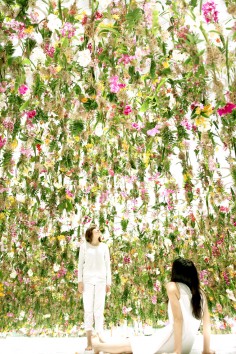teamlab
チームラボ
floating flower garden
source: team-labnet
チームラボ 踊る!アート展と、学ぶ!未来の遊園地
2012年の春から夏にかけて、チームラボは台湾の「National Museum」で、アートからプロダクトまでを含めた19作品にも及ぶ、はじめて美術館で行う個展を行いました。
当時、僕もびっくりしたことなのですが、大勢が同時に関わる作品の中で子供たちが大はしゃぎで、共同でとても知的に創造的なことを行っていたのです。その様子を見て始まったのが、「学ぶ!未来の遊園地」です。日本でも、子どもがアートに触れながら、同じ空間で他の人々と共同的で創造的な体験をしてもらいたいと思ったのです。自由に騒げる空間で!
一方、その間、僕らは、“チームラボ”という個人名ではない現代アーティストとして、世界各地での発表を続け、2014年の夏には、ニューヨークではじめて個展を開き大盛況に終わりました。人類が新しく手に入れたデジタルという概念は、便利だとかコストの革新だけではなく、美の概念を拡張できると、僕らは信じています。それは、アートと人の関係性を変え、アートを見て感じるだけではなく、より参加し、空間で体感するものへと変えるのです。 そして、今回、やっと東京。日本では、チームラボとして一カ所で行うはじめての大個展です。そして、その場所が偶然にも「National Museum」である日本科学未来館なのです。ここで、もともと同じ場所からスタートし、それぞれに発展したアートと遊園地を、もう一度くっつけて展示することにしました。
僕らは、「デジタルという新たな方法論によって、古来の日本の空間認識の論理構造を模索する」というサイエンス的なアプローチを試みています。そしてそれを再利用することによって新たな視覚体験を試みたり、近現代の人々の世界の捉え方への問いを投げかけたりしています。近代社会とは相性が悪かったために捨てられたものの中に、新しい社会のヒントがあるのではないかと信じているからです。そして、少なくとも、古来の日本の空間認識の論理構造は、人々が作品に参加し空間を歩き回りながら体感することに対して、大きな可能性を持つのです。そう、近代に捨てられた日本の古来の空間認識は、デジタルによって拡張された美において、再び、花開くのです。
鑑賞者は、じっと止まって鑑賞する必要もなければ、となりの人を邪魔だと思う必要もないのです。そして、アートは美しさを維持したまま、人々の参加によって変化することもできるのです。鑑賞者もアートも、より自由になったのです。
そう、人もアートも、踊れるのです。
子どもも、アートに触れて騒いで良いのです。そして、大人も、創造性にあふれるデタラメな子どもたちに紛れながら、遊園地を楽しんでほしいのです。なぜなら、僕らのアートは、僕らが僕らにとっておもしろいと思うものを創っていたものなのですから。
こんな場を与えていただき、感謝、感謝、超感謝。
そして、応援してくれて、いつもありがと。
.
.
.
.
.
.
.
source: team-labnet
This is an art installation consisting of a walkway and a large open space that appears to go on for infinity. Flowers in Tokyo form the central motif of the work, changing every hour to reflect the changes of the flowers of Tokyo throughout a year.
Neither a pre-recorded animation nor on loop, the work is being rendered in real time by a computer program. The flowers spring up, grow, bud and blossom before their petals begin withering, and the flowers eventually fade away. The cycle of growth and decay repeats itself in perpetuity. The viewer’s behavior (making sudden movements or standing still) affects the cycle, causing the flowers to either wither and die, or spring up and blossom. The interaction between the viewer and the installation causes continuous change in the artwork; previous visual states can never be replicated, and will never reoccur. What you can see right now will never be repeated again in the future.
When teamLab visited the Kunisaki Peninsula in spring, we saw many cherry blossoms in the mountains and rape blossoms at the mountain base. We began to wonder how many of these flowers were planted by people and how many were propagated by nature. This place, which was simply overflowing with flowers, gave us great contentment. It also made us realize that this large number of flowers was an ecosystem that is influenced by human intervention. The boundary between the work of nature and the work of humans is extremely vague. In other words, nature and humans are not antagonistic concepts, but rather, a pleasant nature is an ecosystem that also includes the work of humans. Also, unlike the present day, we could say that the human work of many years based on nature’s predetermined rule that humans are unable understand or control nature, is precisely what has contributed to the creation of this pleasant nature. Before the present day, people used to flourish and prosper along sea routes, but nowadays our focus has moved onto land routes. During our trip, we were made to wonder whether there is still something left of the pre-modern time relationship between humans and nature within our secluded valley of human habitation of many years. We also wondered what kind of behavior would constitute artificial behavior toward nature based on this premise that nature cannot be controlled, and whether these behaviors could perhaps give us clues about the future.
.
.
.
.
.
.
.
source: team-labnet
teamLab is an Ultra-technologists group made up of specialists in the information society such as; Programmers (User Interface Engineers, Database Engineers, Network Engineers, Hardware engineers, Computer Vision Engineers, Software Architects), Mathematicians, Architects, CG Animators, Web Designers, Graphic Designers, Artists, Editors and more. We create works through “experimentation and innovation” making the borders between Art, Science, and Technology, more Ambiguous.


